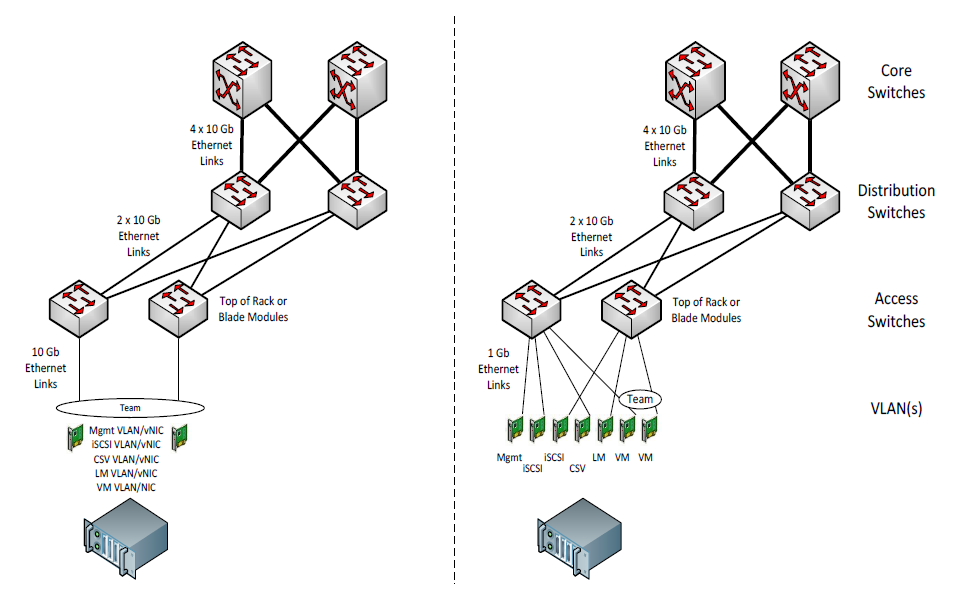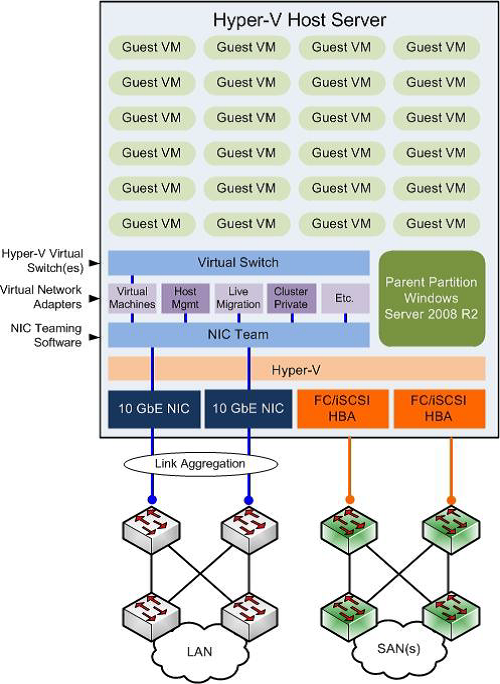Network Architecture for Private Cloud
Note: This article is no longer being updated by the Microsoft team that originally published it. It remains online for the community to update, if desired. Current documents from Microsoft that help you plan for cloud solutions are found at the TechNet Library Solutions or Cloud and Datacenter Solutions pages.
Many network architectures include a tiered design with three or more tiers such as Core, Distribution, and Access. Designs are driven by the port bandwidth and quantity required at the edge, as well as the ability of the Distribution and Core tiers to provide higher-speed uplinks to aggregate traffic. Additional considerations include Ethernet broadcast boundaries and limitations, and spanning tree and or other loop avoidance technologies.
The diagram below illustrates two potential designs, one that carries redundant 10-GB Ethernet
connections to each host and another that carries multiple 1-GB Ethernet connections to each host.

Figure 1: Example of common network architectures
In the implementation of this network, the following requirements must be met:
- The network switches must support 802.1q VLAN trunks.
- The network switches must support an Ethernet link aggregation standard that is compatible
with the rack or blade server NICs such that NIC teams can span two or more switches. - The network switches must support Ethernet link aggregation such that multiple uplink ports
can be bonded together for high bandwidth. - The network design must allow for the loss of any switch module or switch without dropping
host server connectivity.
IP Networks Configuration
Ensure that the following rules are followed when setting up the IP network:
- The cluster heartbeat network must be on a distinctly separate subnet from the host management network.
- The VM network adapter should not be shared with the host operating system and therefore should not have the TCP/IP protocols (IPv4 and IPv6) bound to it.
- The iSCSI network must be on a distinctly separate and isolated network, with a dedicated IP range used only for storage.
NIC Teaming Configuration
NIC teaming or link aggregation (IEEE 802.3ad) enables network maintenance to occur at all points within the data center network topology without affecting applications. This technology bonds physical NICs together to form one or more logical network team that sends traffic to all NICs in the team. This allows a single NIC, cable, or switch to sustain a planned or unplanned outage without disrupting the host’s Ethernet traffic. The NIC manufacturer is also the software provider for the NIC teaming software. Each NIC teaming software application has its own unique set of requirements, features, teaming modes, and configuration recommendations. NIC teaming should be used to provide high availability to the VM networks.
Figure 2: Example of a common NIC teaming design
